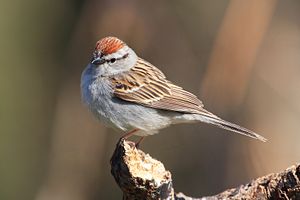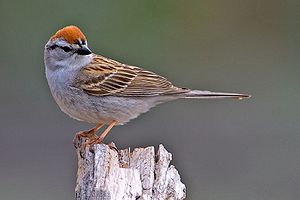- Schwirrammer
-
Schwirrammer 
Schwirrammer (Spizella passerina)
Systematik Klasse: Vögel (Aves) Ordnung: Sperlingsvögel (Passeriformes) Unterordnung: Singvögel (Passeri) Familie: Emberizidae Gattung: Spizella Art: Schwirrammer Wissenschaftlicher Name Spizella passerina (Bechstein, 1798) Die Schwirrammer (Spizella passerina) ist ein kleiner Sperlingsvogel aus der Familie der Ammern. Die Schwirrammer ist in fast ganz Nordamerika verbreitet.
Inhaltsverzeichnis
Merkmale
Altvögel haben eine rostfarbene Haube, einen dunklen Schnabel und einen grauen Unterkörper. Sie haben einen braunen Rücken mit dunklen Streifen, braune Flügel mit weißen Strichen und einen schmalen Schwanz. Ihr Gesicht ist grau mit einer horizontalen schwarzen Linie die über das Auge geht.
Lebensraum
Der ursprüngliche Lebensraum der Schwirrammern waren wahrscheinlich Nadelwälder, aber durch Anpassung an die Veränderungen mit der zunehmenden Besiedlung durch Menschen, wurden neue Lebensräume erschlossen. Sie lebt heute in Wäldern, landwirtschaftlich genutzten Flächen, Parkanlagen und in städtischen Vorbezirken in Nordamerika. Die Schwirrammer zieht im Winter nach Mexiko und in die südlichen Bundesstaaten der USA.
Lebensweise
Die Schwirrammern suchen am Boden oder in niedrigen Büschen nach Futter. Manchmal fangen sie auch im Flug Insekten. Die Hauptnahrungsquelle sind Insekten und Samen. Außerhalb der Brutzeit leben die Schwirrammern in Schwärmen. Ihr Gesang ist ein einfaches Trillern. Ihre Nester baut die Schwirrammer üblicherweise in Nadel- oder Laubbäumen und gelegentlich auch auf dem Boden.
Literatur
Bücher
- Middleton, A. L.,Chipping Sparrow (Spizella passerina), in The Birds of North America, 334/1998, Philadelphia, PA.
Artikel in Journals
- Albrecht DJ & Oring LW. (1995). Song in chipping sparrows, Spizella passerina: Structure and function. Animal Behaviour. vol 50, p. 1233-1241.
- Anderson SH & Van Hook RIJ. (1973). Uptake and Biological Turnover of Cadmium-109 in Chipping Sparrows Spizella-Passerina. Environmental Physiology & Biochemistry. vol 3, no 5. p. 243-247.
- Braestrup FW. (1968). Evolution of Vertebrates Parus-Ater Parus-Cristatus Parus-Montanus Nemeritis-Canescens Phylloscopus-Sibilatrix Delichon-Urbica Spizella-Passerina Peromyscus-Maniculatus Turdus-Merula Turdus-Viscivorus Acrocephalus-Palustris. Zoologischer Anzeiger. vol 181, no 1/2. p. 1-22.
- Catherine PO & Joseph CO. (2001). Effects of Brown-headed Cowbirds on the nesting success of Chipping Sparrows in southwest Colorado. The Condor. vol 103, no 1. p. 127.
- Dawson WR, Carey C, Adkisson CS & Ohmart RD. (1979). Responses of Brewers Sparrows Spizella-Breweri and Chipping Sparrows Spizella-Passerina to Water Restriction. Physiological Zoology. vol 52, no 4. p. 529-541.
- Earley CG. (1991). BROWN-HEADED COWBIRD, MOLOTHRUS-ATER, SEEN REMOVING A CHIPPING SPARROW, SPIZELLA-PASSERINA, EGG. Canadian Field-Naturalist. vol 105, no 2. p. 281-282.
- Fillmore ER & Titman RD. (1977). CHIPPING SPARROW HANGED. Canadian Field-Naturalist. vol 91, no 1. p. 69-69.
- Foster J & Tozer R. (2001). Chipping sparrow feeds young of Eastern Kingbird. Ontario Birds. vol 19, no 2. p. 79-83.
- Liu W-C & Kroodsma DE. (1999). Song development by chipping sparrows and field sparrows. Animal Behaviour. vol 57, p. 1275.
- Liu W-C & Kroodsma DE. (2007). Dawn and daytime singing behavior of chipping sparrows (Spizella passerina). Auk. vol 124, no 1. p. 44-52.
- Middleton ALA & Prescott DRC. (1989). POLYGYNY, EXTRA-PAIR COPULATIONS, AND NEST HELPERS IN THE CHIPPING SPARROW, SPIZELLA-PASSERINA. Canadian Field-Naturalist. vol 103, no 1. p. 61-64.
- Moldenha.Rr & Taylor PG. (1973). ENERGY-INTAKE BY HYDROPENIC CHIPPING SPARROWS (SPIZELLA-PASSERINA-PASSERINA) MAINTAINED ON DIFFERENT DIETS. Condor. vol 75, no 4. p. 439-445.
- Pulliam HR. (1980). Do Chipping Sparrows Spizella-Passerina-Arizonae Forage Optimally. Ardea. vol 68, no 1-4. p. 75-82.
- Reynolds JD & Knapton RW. (1984). Nest-Site Selection and Breeding Biology of the Chipping Sparrow Spizella-Passerina. Wilson Bulletin. vol 96, no 3. p. 488-493.
- Scott DM. (1988). HOUSE SPARROW AND CHIPPING SPARROW FEED THE SAME FLEDGLING BROWN-HEADED COWBIRD. Wilson Bulletin. vol 100, no 2. p. 323-324.
- Simmons GA & Sloan NF. (1974). Consumption of Jack-Pine Budworm Choristoneura-Pinus by the Eastern Chipping Sparrow Spizella-Passerina. Canadian Journal of Zoology. vol 52, no 7. p. 817-821.
- Sloan NF & Simmons GA. (1973). Foraging Behavior of the Chipping Sparrow in Response to High Populations of Jack Pine Budworm. American Midland Naturalist. vol 90, no 1. p. 210-215.
- Stewart PA. (1968). Bird Migration through an Abandoned Farmstead Richmondena-Cardinalis Behavior Dendroica-Palmarum Guiraca-Caerulea Spizella-Passerina. Chat. vol 32, no 4.
- Swanson HM, Kinney B & Cruz A. (2004). Breeding biology of the Chipping Sparrow in ponderosa pine forests of the Colorado Front Range. Wilson Bulletin. vol 116, no 3. p. 246-251.
- Wan-Chun L. (2004). The effect of neighbours and females on dawn and daytime singing behaviours by male chipping sparrows. Animal Behaviour. vol 68, p. 39.
- Wan-Chun L & Donald EK. (2006). SONG LEARNING BY CHIPPING SPARROWS: WHEN, WHERE, AND FROM WHOM. The Condor. vol 108, no 3. p. 509.
- Zink RM & Dittmann DL. (1993). Population structure and gene flow in the chipping sparrow and a hypothesis for evolution in the genus Spizella. The Wilson Bulletin. vol 105, no 3. p. 399-413.
Weblinks
- Videos, Fotos und Tonaufnahmen zu Spizella passerina in der Internet Bird Collection
alle in englischer Sprache:
- Chipping Sparrow - Spizella passerina - USGS Patuxent Bird Identification InfoCenter
- Chipping Sparrow Species Account - Cornell Lab of Ornithology
- Chipping Sparrow Information and Photos - South Dakota Birds and Birding
Wikimedia Foundation.

